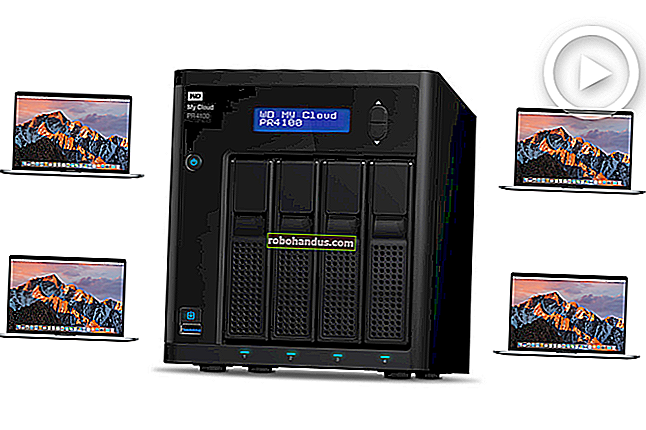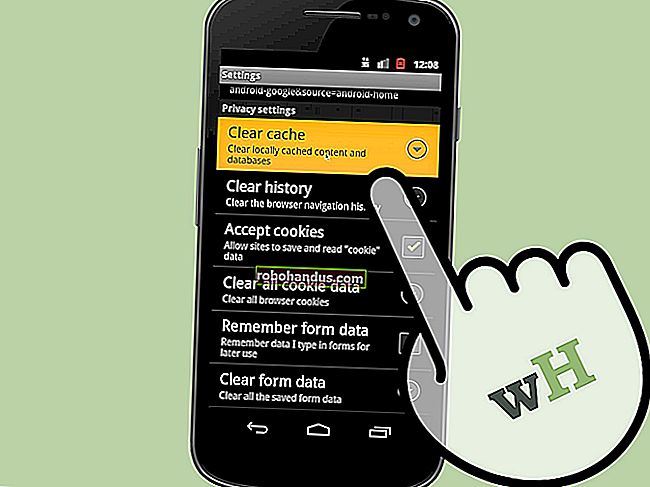Cara Mengubah Raspberry Pi menjadi Kotak BitTorrent yang Selalu Aktif

Sangat ideal untuk memiliki mesin khusus untuk klien BitTorrent Anda, sehingga Anda dapat melakukan seed 24/7. Tetapi membutuhkan energi yang intensif untuk membiarkan rig penuh menyala dan sering online. Masuk ke Raspberry Pi.
TERKAIT: Panduan How-To Geek untuk Mengukur Penggunaan Energi Anda
Sebagian besar PC desktop menghabiskan cukup banyak energi — server kantor rumah kami yang sederhana, misalnya, menghabiskan listrik senilai hampir $ 200 per tahun. Raspberry Pi, di sisi lain, dibangun di sekitar prosesor seluler dan menyerap energi seperti burung kolibri. Papan inti Raspberry Pi menggunakan kurang dari $ 3 energi per tahun dan bahkan menambahkan beberapa hard drive eksternal, Anda akan tetap menjaga biaya operasi tahunan Anda kurang dari burger dan kentang goreng.
Plus, dalam hal mengunduh torrent, mesin yang selalu aktif adalah rajanya. Dengan torrent, semakin Anda memantau cloud dan memasukkannya ke dalamnya, semakin baik rasio Anda pada pelacak Anda (bahkan jika Anda memanfaatkan pelacak publik, mesin yang selalu aktif memastikan Anda akan berada di sana saat file langka itu muncul) .
Jika kedengarannya bagus, baca terus selagi kami tunjukkan cara mengubah Pi Anda menjadi mesin pengunduh yang dikendalikan dari jarak jauh.
Apa yang kau butuhkan

Untuk tutorial ini, kami berasumsi bahwa Anda memiliki unit Raspberry Pi dengan Raspbian diinstal, dapat mengakses perangkat baik secara langsung melalui monitor dan keyboard yang terpasang atau dari jarak jauh melalui SSH dan VNC, dan bahwa Anda memiliki drive (atau drive) USB eksternal melekat padanya. Jika Anda ingin mengetahui kecepatan di area ini, kami sangat menyarankan untuk membaca panduan berikut sesuai urutan yang kami cantumkan di sini:
- Semua yang Perlu Anda Ketahui Tentang Memulai dengan Raspberry Pi
- Cara Mengonfigurasi Raspberry Pi Anda untuk Remote Shell, Desktop, dan Transfer File
- Cara Mengubah Raspberry Pi menjadi Perangkat Penyimpanan Jaringan Berdaya Rendah
Semua yang ada di tutorial pertama diperlukan. tutorial kedua adalah opsional (tetapi akses jarak jauh sangat berguna untuk proyek ini, karena kotak unduhan adalah kandidat yang sempurna untuk pembuatan tanpa kepala), dan bagian terpenting dari tutorial ketiga hanyalah menyiapkan hard drive dan mengkonfigurasi untuk memasang otomatis saat boot (seperti yang dijelaskan di panduan ketiga).
TERKAIT: Cara Menganonimkan dan Mengenkripsi Lalu Lintas BitTorrent Anda
Selain itu, jika Anda tidak terlalu paham dengan seluk beluk menyiapkan klien BitTorrent untuk pengunduhan anonim, Anda harus membacanya. Anda benar - benar membutuhkan semacam proxy anonim atau sistem VPN untuk menggunakan BitTorrent dengan aman. Proksi yang disebutkan dalam panduan itu murah dan mudah, tetapi VPN yang bagus biasanya lebih cepat dan lebih serbaguna, jadi lihat panduan ini jika Anda menginginkan VPN.
Setelah Anda meninjau semua materi dan mengonfigurasi Pi, saatnya untuk turun ke bisnis mengubah Pi Anda menjadi binatang pengunduh yang diam dan sangat rendah daya.
Langkah Satu: Instal Deluge di Raspbian

Ada beberapa klien BitTorrent untuk Linux yang layak dipertimbangkan, tetapi kami merekomendasikan Deluge. itu hanya keseimbangan yang tepat antara fitur dan footprint sehingga Anda tidak akan berharap sebulan dari sekarang Anda telah menginstal sesuatu yang lebih kuat.
Anda dapat mengonfigurasi Deluge dengan berbagai cara, tetapi tidak semua konfigurasi cocok untuk kotak unduhan Pi tanpa kepala ini. Meskipun kebanyakan orang menggunakan klien torrent mereka di desktop seperti aplikasi lain, ini tidak berfungsi dengan baik untuk tujuan kami, karena itu berarti setiap kali Anda ingin berinteraksi dengan torrent Anda, Anda harus masuk ke kotak melalui remote desktop dan bermain-main dengan klien desktop. Itu membuang-buang waktu Anda dan membuang-buang sumber daya di Pi.
Anda dapat menjalankan Deluge WebUI, yang memungkinkan Anda mengakses klien Deluge dari browser di komputer lain. Ini masih bukan pilihan kami, meskipun itu membuka potensi penggunaan aplikasi smartphone untuk melihat dan mengontrol Banjir (lebih lanjut tentang ini nanti).
Kami menyarankan untuk mengonfigurasi Deluge pada mesin jarak jauh untuk menerima koneksi ThinClient. Dengan cara ini, kita dapat menggunakan klien desktop Deluge yang sebenarnya di komputer lain (baik itu Windows, Linux, atau kotak OS X) untuk mengontrol instalasi Raspberry Pi Deluge. Anda mendapatkan semua manfaat dari klien desktop di desktop Anda yang sebenarnya, sementara semua tindakan terjadi di kotak jarak jauh.
Jika Anda tidak dapat memutuskan di antara kedua opsi tersebut, Anda sebenarnya dapat menggunakan keduanya secara bersamaan, meskipun akan memakan waktu lebih lama untuk menyiapkannya. Ikuti saja petunjuk di kedua bagian di bawah ini untuk melakukannya.
Opsi Satu: Siapkan Deluge untuk ThinClient Access
Sebelum Anda melakukan apa pun, luangkan waktu sejenak untuk memperbarui dan meningkatkan repositori Anda. Buka Terminal dan jalankan dua perintah berikut, satu demi satu:
sudo apt-get updatesudo apt-get upgrade
Setelah selesai, saatnya untuk mulai menginstal komponen yang diperlukan untuk pengaturan ThinClient. Masukkan perintah berikut:
sudo apt-get install delugedsudo apt-get install deluge-console
Ini akan mengunduh daemon Deluge dan paket instalasi konsol dan menjalankannya. Saat diminta untuk melanjutkan, ketik Y. Setelah Deluge selesai diinstal, Anda perlu menjalankan daemon Deluge. Masukkan perintah berikut:
delugedsudo pkill deluged
Ini memulai daemon Deluge (yang membuat file konfigurasi) dan kemudian mematikan daemon. Kami akan mengedit file konfigurasi itu dan kemudian memulainya kembali. Ketik perintah berikut untuk membuat cadangan file konfigurasi asli terlebih dahulu, kemudian membukanya untuk diedit:
cp ~/.config/deluge/auth ~/.config/deluge/auth.oldnano ~/.config/deluge/auth
Once inside the nano text editor, you’ll need to add a line to the bottom of the configuration file with the following convention:
user:password:levelWhere user is the username you want for Deluge, password is the password you want, and thelevel is 10 (the full-access/administrative level for the daemon). So for our purposes, we used pi:raspberry:10. When you’re done editing, hit Ctrl+X on your keyboard and save your changes when prompted. Then, start up the daemon and console again:
delugeddeluge-console
If starting the console gives you an error code instead of nice cleanly formatted console interface, type “exit” and then make sure you’ve started up the daemon.
Once inside the console, you’ll need to make a quick configuration change. Enter the following:
config -s allow_remote Trueconfig allow_remoteexit
The commands and corresponding output will look like the screenshot below.

This enables remote connections to your Deluge daemon and double checks that the config variable has been set. Now it’s time to kill the daemon and restart it one more time so that the config changes take effect:
sudo pkill delugeddeluged
At this point, your Deluge daemon is ready for remote access. Head to your normal PC (not the Raspberry Pi) and install the Deluge desktop program. You’ll find the installer for your operating system on the Deluge Downloads page. Once you’ve installed Deluge on your PC, run it for the first time; we need to make some quick changes.
Once launched, navigate to Preferences > Interface. Within the interface submenu, you’ll see a checkbox for “Classic Mode”. By default it is checked. Uncheck it.

Click OK and then restart the Deluge desktop client. This time, when Deluge starts, it will present you with the Connection Manager. Click the “Add” button and then input the IP address of the Raspberry Pi on your network, as well as the username and password you set during the earlier configuration. Leave the port at the default 58846. Click Add.

Back in the Connection Manager, you’ll see the entry for the Raspberry Pi; if all goes well, the indicator light will turn green like so:

Click Connect, and you’ll be kicked into the interface, connected to the remote machine:

It’s a fresh install, nary a .torrent in site, but our connection between the remote machine and the desktop client is a success!
Go ahead and configure the WebUI now (if you wish to do so), or skip down to the next step of this tutorial.
Option Two: Set Up Deluge for WebUI Access
Configuring the WebUI is significantly faster, and allows for using some mobile apps to access Deluge. But as we mentioned before, you’ll have access to fewer features than with the full ThinClient experience. For example, ThinClient can associate .torrent files with the Deluge ThinClient for automatic transfer to the Pi, but you can’t do this with the WebUI.
First, take a moment to update and upgrade your repositories. Open a Terminal and run the following two commands, one after the other:
sudo apt-get updatesudo apt-get upgrade
Then, to install the WebUI, run the following commands. Note: If you already installed the Deluge daemon in the ThinClient section of the tutorial, skip the first command here.
sudo apt-get install delugedsudo apt-get install python-makosudo apt-get install deluge-webdeluge-web
This sequence installs the Deluge daemon (if you didn’t already install it in the last section), Mako (a template gallery for Python that the WebUI needs), the WebUI itself, and then starts the WebUI program.
The default port for the WebUI is 8112. If you wish to change it, run the following commands:
sudo pkill deluge-webnano ~/.config/deluge/web.conf
This stops the WebUI and opens up the configuration file for it. Use nano to edit the line: “port”: 8112, and replace the 8112 with any port number above 1000 (as 1-1000 are reserved by the system).
Once you have the WebUI up and running, it’s time to connect to it using a web browser. You can use a browser on the Pi if you ever need to, but it’s not the most pleasant user experience and best left for emergencies. Open up a browser on your regular desktop machine and point it at the IP address of your Pi with the port you just chose (e.g. //192.168.1.13:8112 ).
You’ll be greeted with a password prompt (the default password is “deluge”) and be immediately encouraged to change it after you enter it for the first time. After that, you’ll be able to interact with Deluge via the lightweight interface.

It’s not quite the same as the ThinClient, but it’s robust enough for light use and has the added benefit of serving as the point of connection for lots of torrent-control mobile apps.
Step Two: Configure Your Proxy or VPN
You might be tempted to start downloading torrents now,but wait! Don’t do that yet. It’s absolutely reckless to use a BitTorrent Client without first shuttling your connection through a proxy server or VPN.
RELATED:How to Choose the Best VPN Service for Your Needs
If you didn’t read over How To Anonymize and Encrypt Your BitTorrent Traffic yet, now is the time to do so. Read over the first section (for a better understanding of why it is important to protect your BitTorrent connection), and then sign up for a proxy service or, better yet, a good VPN before continuing on.
If you’re using a VPN, it’s pretty simple: Just choose a VPN that offers a Linux client. Then, download and install the Linux client on your Pi, start it up, and connect to your desired server. (You may even want to set it to launch when the Raspberry Pi boots, so it’s always connected to the VPN.)
If you’re using a proxy, you can plug its information into Deluge under Preferences > Proxy. You need to fill out the Peer, Web Seed, Tracker, and DHT sections like so, placing your proxy username and password in the appropriate slots. Your proxy service’s Type, Host, and Port may differ, so be sure to check its documentation.

In order for the proxy settings to take effect, you need to restart the Deluge daemon. From the terminal enter the following commands:
sudo pkill delugeddeluged
After that, you should be all set.
The best way to test that you’re actively using the proxy or VPN is to download a torrent file designed expressly to report back its IP address. You can find many of these torrents online, including this one from BTGuard and this one from TorGuard. Load either or both torrents into Deluge and wait a moment.

After the torrents have had a chance to connect to their respective trackers, select the torrents in the Deluge client and check the “Tracker Status” entry as seen above. Both will report the IP address they detect from your client. If that IP address matches your public IP address, then the proxy or VPN is not configured properly and you should return to the previous section to check your configuration. If it is configured properly, you’ll see the proxy or VPN’s IP address and not your own.
Step Three: Configure Your Download Location
Next, you’ll need to configure Deluge to use your external hard drive. If you followed along with the hard drive mounting instructions in this previously mentioned guide, you’re ready with a hard drive set to auto-mount on boot.
From there, all you need to do is change the default locations in Deluge. Navigate to Deluge’s Preferences and head to the Downloads tab. By default, Deluge directs everything to /home/pi. That little SD card is going to fill up real fast, however, so we need to change it.
First, we’re going to create some new folders in /media/USBHDD1/shares, which is the share folder we already set up in the Low-Power Network Storage tutorial. That way, we can easily access our downloaded torrents over the network and have a network accessible watch folder for auto-loading torrent files. Use the following commands to create the folder set (adjusting the pathnames accordingly for your location if you’re not using the same Pi setup from the previous tutorial like we are):
sudo mkdir /media/USBHDD1/shares/torrents/downloading sudo mkdir /media/USBHDD1/shares/torrents/completed sudo mkdir /media/USBHDD1/shares/torrents/watch sudo mkdir /media/USBHDD1/shares/torrents/torrent-backupsThen, turn right around and plug those four new directories into Deluge.

Click OK to set the directories. There’s no need to restart as you did with the proxy setup.
Step Four: Test Your Connection
Now it’s time to download a large enough torrent that we can really see if the system is running smoothly. For our test we grabbed the .torrent file for the current Linux Mint distribution–it weighs in at solid 1.7GB, perfect for monitoring the connection speeds.

Once you’ve confirmed that your connection is stable and the Linux torrent is humming along nicely, it’s time to move onto the next step: automating the client startup.
Step Five: Configure Deluge to Run on Startup
Before we leave the Deluge setup, there is one final detail to attend to. We need to set up the Deluge daemon and WebUI to run automatically when our Raspberry Pi boots up. To do so simply and without the fuss of editing more complicated init files and settings, we’ll simple annotate the rc.local file. Run the following command in a Terminal to do so.
sudo nano /etc/rc.local
With the rc.local file loaded, add the following lines to the end of the file. Note: you do not need to add the the second command ending in “deluge-web” if you are not using the WebGUI. This may also be a good place to add your VPN program, if you’re using one.
# Start Deluge on boot: sudo -u pi /usr/bin/python /usr/bin/deluged sudo -u pi /usr/bin/python /usr/bin/deluge-web
Your rc.local file should look something like this when you’re done (possibly with the addition of that VPN):

Press Ctrl+X to exit and save your work.
At this point, we would recommend restarting your Raspberry Pi, so fire off a “sudo reboot” at the command line. Once the Pi has finished rebooting, head to your other PC and try to connect to the Deluge ThinClient and/or WebUI to make sure they both work.
There are two major errors you may encounter here. First, a failure to connect at all means that the initialization scripts didn’t work. Open up the terminal on your Pi and manually start the daemon and WebUI using the commands we learned earlier in the tutorial. Check to see that it works now. If it does, go back up and fix your rc.local script.
Second, if you can open up the client, but it shows permission errors for your existing torrents (like the Linux torrent we used to test things earlier), that indicates that your external hard drive was not mounted, or mounted incorrectly. Review the sections on installing an external drive and setting it to auto-mount on boot in our Low-Power Network Storage tutorial.
Enhancing Your Torrenting Experience
Now that you have your torrent box configured and ready to rock, there are a few additional tools and modifications you can look into to really enhance your user experience. None of these tips and tricks are necessary, but they do make your Raspberry Pi turned Torrent Box easier to use.
Add Mobile Access: Consider downloading a mobile control app like Transdroid and Transdrone for Android. Unfortunately we don’t have any solid suggestions for iOS users, as Apple has taken a really aggressive stance towards torrent-related apps in the App Store (and has banned any apps that slipped through the submission process).
Deluge doesn’t currently have a mobile-optimized template for the WebUI, but it’s more than functional on tablets like the iPad and Kindle Fire.
Set Up a Shared Drop Folder: Although we mentioned it briefly earlier in the tutorial, ensure that the /torrents/watch/ folder you created is accessible on your network. It’s really convenient to be able to dump a pile of .torrent files into the folder and have Deluge load them up automatically.
Install Browser Plugins: There are several Deluge-centered plugins for Chrome and Firefox that improve the user experience, including:
- Chrome:
- DelugeSiphon: Enables .torrent adding from the WebUI
- Deluge Remote: Simple view of current torrents and their progress
- Firefox:
- BitTorrent WebUI+: Enables .torrent adding from the WebUI
- WebUI Quick Add Torrent: Greasemonkey Script that adds clickable icon on webpages for easy torrent adding
Activate Deluge Plugins: There are a host of great plugins already included in Deluge, and even more third-party plugins. Some of the included plugins you may want to take advantage of include:
- Notification: You receive email alerts from Deluge on torrent completion and other events
- Scheduler: Limit bandwidth based on time of day
You can find these in Preferences > Plugins. Check the ones you want and a new entry will appear in the preferences menu (e.g. Preferences > Notifications).
For more information about third party plugins and how to install them, check out the Plugins page in the Deluge Wiki.
After configuring, testing, and tweaking enhancements and plugins, you have a more than capable torrent box that costs mere pennies a day to operate. Find a quiet and out of the way spot to plug it in, load it up with torrents, and leave it to do the heavy lifting of downloading and seeding for you.






